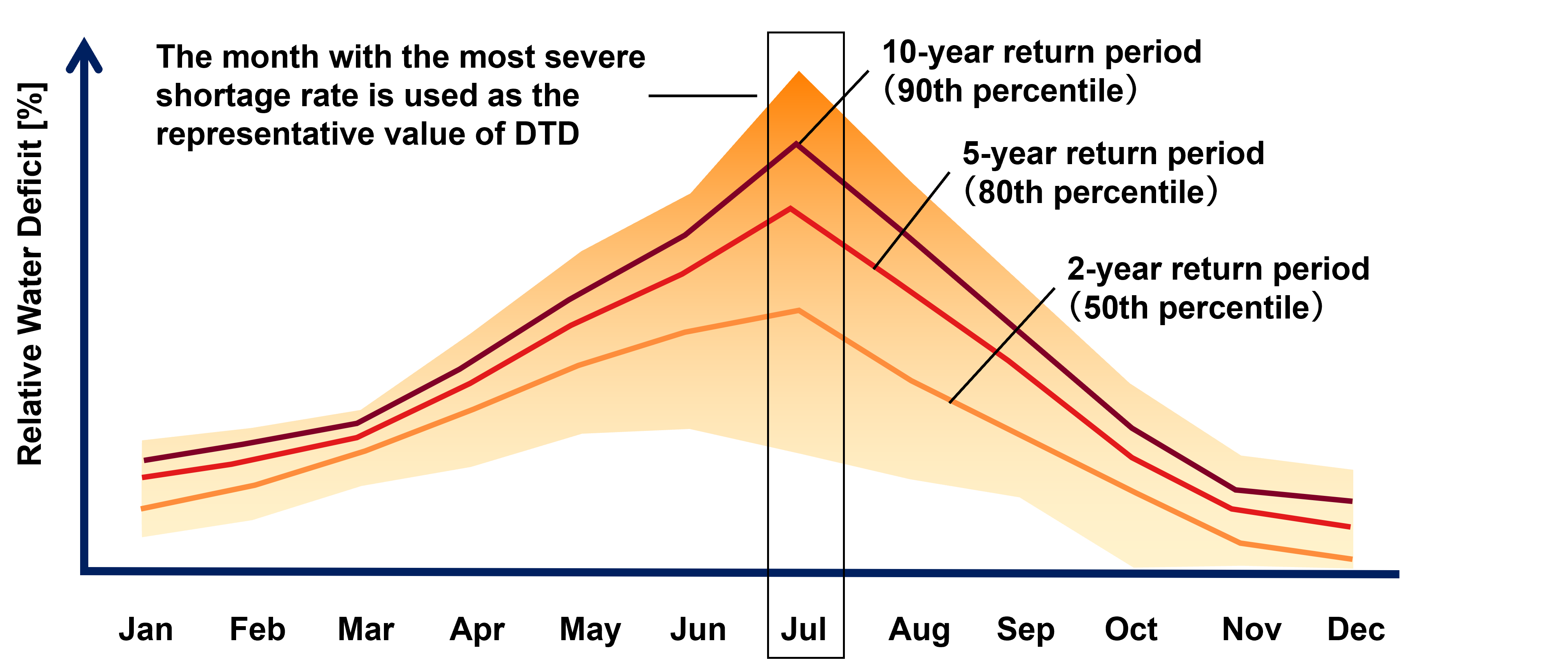Indicators
Based on the latest research on hydrology and water cycle soundness, Water Security Compass beta provides the maps and data of 7 indicators and the input information that was used to compute them (Table 1). The objective of working with these indicators, as shown in Figure 1, is to help different sectors and businesses determine:
- What is the water-related risk due to their dependency on water resources in a particular location?
- To what extent is their consumption of water impacting the consumption of other sectors or pressuring the environment of a particular region?

Except for those marked as “pre-published”, articles of which are currently being prepared for peer-review, the complete definition and calculation process of all indicators listed in Table 1 can be found in their respective peer-reviewed articles. The calculation of the indicators for a given watershed employs the respective available water resources and demand volumes. It is worth noting that the timestep at which the volumes are aggregated and the way the demand is calculated differs from one indicator to another. Click next to the indicator’s name in the table to get more information about the calculation process.
Water Withdrawal and Consumption
Depending on the indicator, the demand volume corresponds to water volumes of either withdrawal or consumption. The former volume represents the water withdrawn from the water resources that are available in the watershed where a business conducts its activities and is useful to differentiate between water users, identify the competition between sectors, and evaluate the potential risk of water supply restrictions. Hence, water withdrawals can be employed as demand volumes to evaluate a business dependency on natural resources. Water consumption are volumes that were withdrawn but were not returned to the same water body and include evaporation, transpiration, integration into a product, or release into a different watershed or the sea (International Standard ISO 14046). Thus, water consumption can be used to assess the impact on the water that is used downstream the evaluation point or the pressure on the environment and ecosystems of the whole watershed.
| Category | Assessment Objective | Name (Click on the indicator for details) |
Units | Spatial Resolution | Temporal Resolution | ||
|---|---|---|---|---|---|---|---|
| Annual Value | Ocurrence Probability | Monthly Value | |||||
| Indicators | Dependency Risks | Cumulative Deficit To Demand (CDTD) | [%] | Sub-basin | ✓ | N/A | N/A |
| Deficit To Demand (DTD)* | [%] | Sub-basin | ✓ | 50%, 80%, 90% | ✓ | ||
| Sectoral and Statistical Demand to Availability (SS-DTA) | [-] | Sub-basin | ✓ | 50%, 80%, 90% | N/A | ||
| SDGs indicator 6.4.2 | [%] | Sub-basin | ✓ | N/A | N/A | ||
| Baseline Water Stress | [%] | Sub-basin | ✓ | N/A | N/A | ||
| Pressure and Impact | Available WAter REmainig (AWARE) | [-] | Sub-basin | ✓ | N/A | N/A | |
| Deficit To Consumption (DTC)* | [%] | Basin | N/A | 80% | ✓ | ||
| Input datasets | Understanding water availability and demand | Water availability | [mm/year] | Sub-basin | ✓ | N/A | N/A |
| Environmental flow requirement | [mm/year] | Sub-basin | ✓ | N/A | N/A | ||
| Human water demand | [mm/year] | Sub-basin | ✓ | N/A | N/A | ||
| Domestic Demand | [m3/s] | 5-arcmin grid | ✓ | N/A | N/A | ||
| Industrial Demand | [m3/s] | 5-arcmin grid | ✓ | N/A | N/A | ||
| Agricultural Demand | [m3/s] | 5-arcmin grid | ✓ | N/A | N/A | ||
Application
An explanation of the application of the indicators provided by Water Security Compass beta is given below.
Evaluating the Dependency Risk on Water Resources:
CDTD and DTD
Water shortages caused by narrow margins of water supply and demand can have numerous effects in the operations of a company. Examples are production disruptions, making supply chains that depend on agricultural products more vulnerable, cost increases, and creating restrictions for business expansion.
Cumulative Deficit to Demand (CDTD) and Deficit to Demand (DTD) take into account seasonal and interannual variations in water resources and water demand to assess the gap between water supply and demand. Of these, CDTD indicates the mean condition of water scarcity, while DTD indicates the monthly water scarcity with different probabilities of occurrence. Naturally, droughts with a frequency of one in two years signify a higher risk than droughts that happen once every five years (Figure 2). The CDTD can be used for relative comparisons of mean condition of water scarcity, and the DTD can be used for an assessment of the impact of a drought on business activities considering the frequency and magnitude of droughts.

Evaluating the Impact on Water Resources
Available WAter REmaining (AWARE)
The adoption of a Global Biodiversity Framework (GBF) at the UN Convention on Biological Diversity (COP15), held in Montréal at the end of 2022, was a global agreement to halt and reverse worldwide biodiversity loss by 2030. The sustainable use and management of biodiversity and the maintenance of nature’s contributions to people, including ecosystems functions and services, are embedded in one of the goals of the GBF. Moreover, several of the targets that are part of this commitment are a call to the corporate sector to further map, analyze, and report on their nature-related impacts and dependencies. Undoubtedly, it has become indispensable for business to quantify the impacts and pressure that their activities put on freshwater resources and ecosystems in order to contribute to the achievement of the goals and targets of the GBF.
For a given water consumption volume, the level of pressure will be more critical in watersheds that have lower rates of freshwater replenishment or drier precipitation regimes. Therefore, it is recommended to evaluate the level of pressure a business is putting on a watershed by comparing water volumes of availability and consumption.
The International Standard ISO 14046 on principles, requirements and guidelines related to water footprint assessment defines water footprint as an indicator of the potential environmental impacts related to water. To assess the potential environmental impacts related to water use, we need to focus on the water consumption volume contributing to water scarcity, which is measured by an indicator denominated water-scarcity footprint. This indicator can be calculated by multiplying the water footprint inventory, which is the total water consumption, and a characterization factor (CF) that represents the local value of water. Water Security Compass beta includes computed and mapped values of AWARE, which is a CF that was developed to be employed in the computation of water-scarcity footprint. In this way, a business can estimate their water-scarcity footprint by simply multiplying the consumption volume of one of their facilities and the respective value of AWARE. Naturally, for the same consumption volume, the impact on the watershed can be more critical for larger values of AWARE.

Notes
Although Water Security Compass beta presents assessment results for specific regions and times of the year, it should be noted that the mapped values are based on global datasets and therefore they have a limited accuracy. We recommend using the data provided here to have a wide picture of the local state of water-related risks and complementing the assessment with finer or more detailed observations.